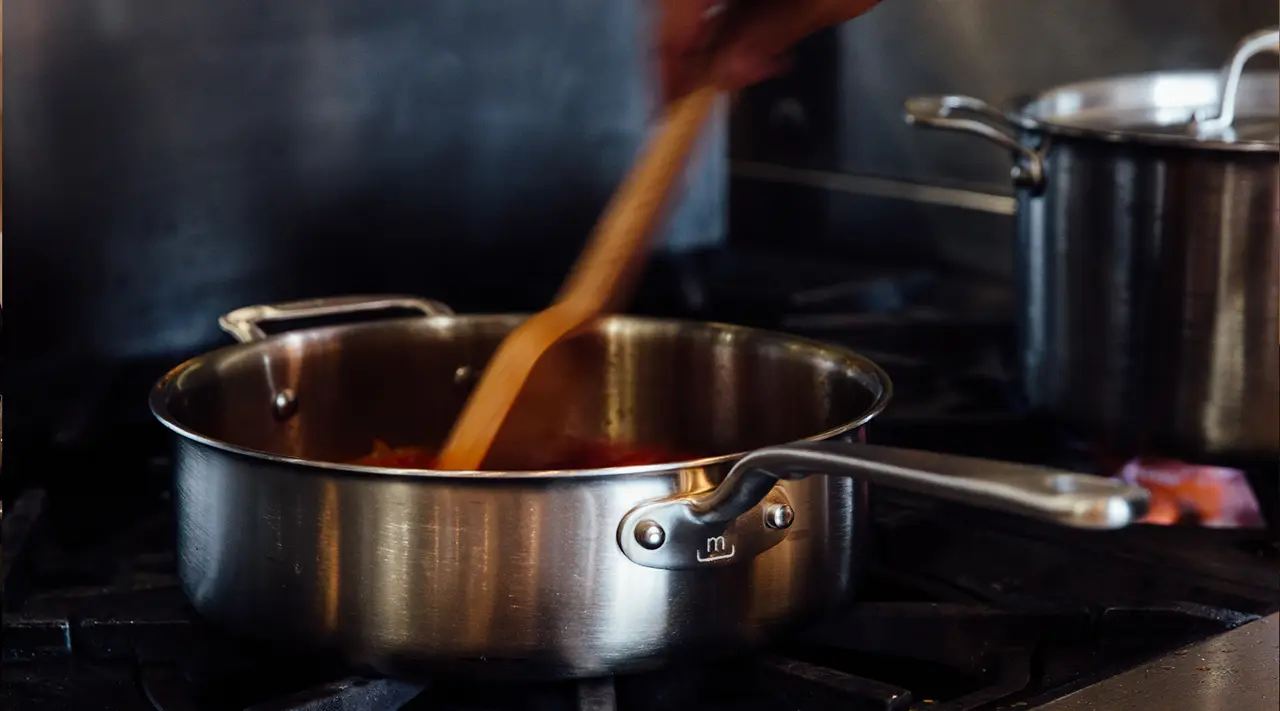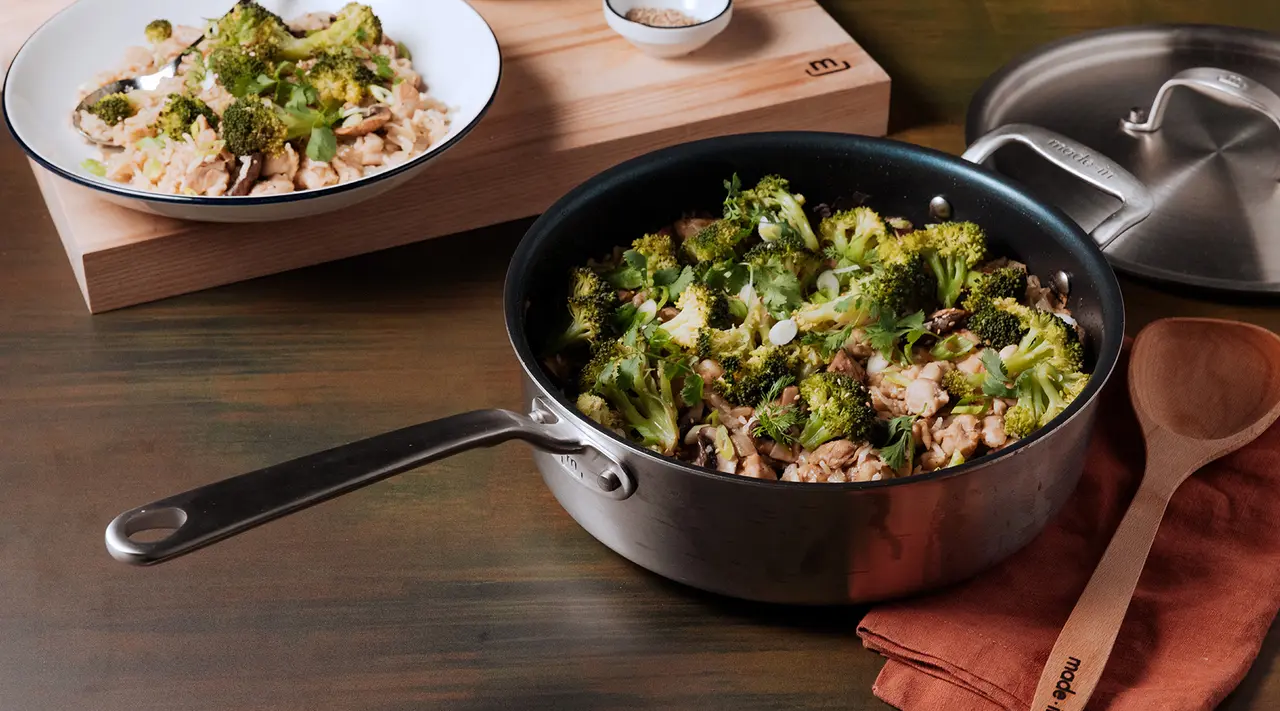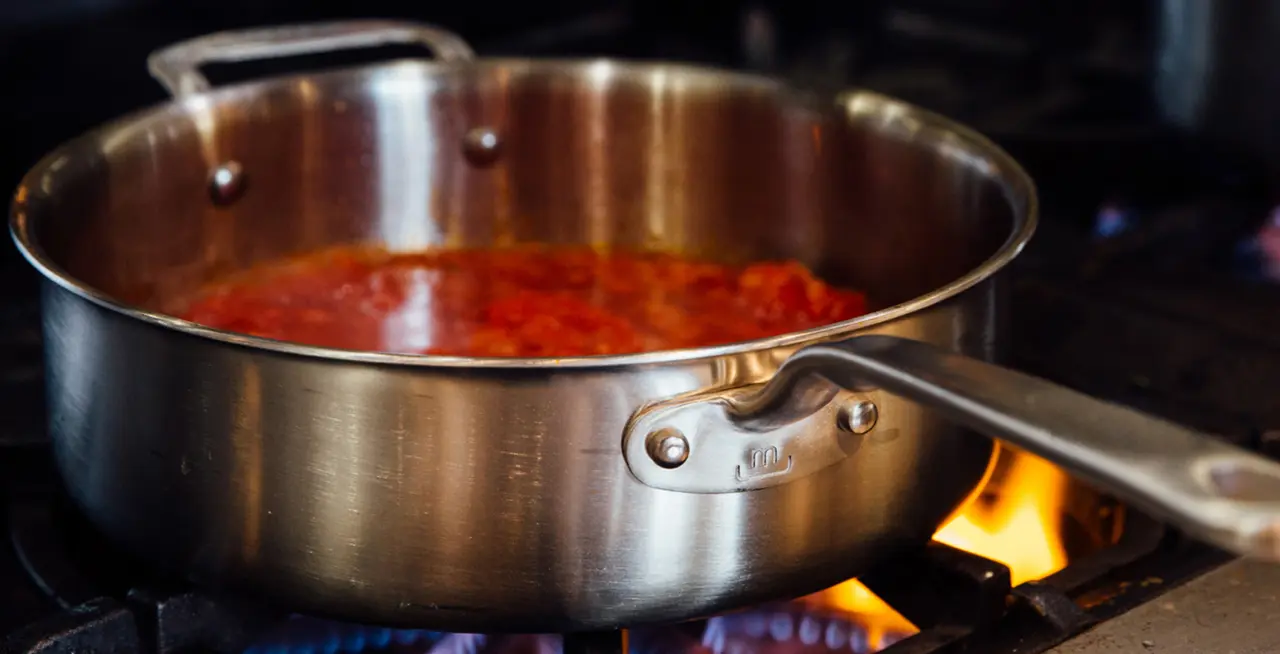A saute pan, or a pan with a large surface area, straight sides, and a helper handle, is an staple in any kitchen. Much like the relationship between a chef and their knives, the relationship between a chef and their pans is sacred. After all, the right or wrong pan can make or break a dish, so knowing which pan to use and when is considered fundamental in a chef’s education.
But because not everyone goes to culinary school, we’re walking you through basic techniques and tools of the trade, starting with the humble saute pan.
What Is a Saute Pan?
Typically used for sautéing, saute pans excel at the stovetop cooking technique derived from a French tradition in which ingredients are cooked in a small amount of fat over moderate heat.
A traditional saute pan has a large surface area and relatively low walls to encourage browning. Typically, walls are straight rather than sloped, as in a frying pan. Our Saute Pan is similar to our Rondeau Pan, albeit slightly smaller and squatter, with a long handle to facilitate the wrist flicking movement associated with sautéing (more on that later).
Thanks to its intentionally large surface area, a saute pan is ideal for dishes that require large quantities of ingredients, building flavor early on for soups and stews, or making sauce-based dishes and braises.
What Is a Saute Pan Used For?
While saute pans excel at (as their name suggests) sautéing, these versatile cookware staples can be used for so much more. Here are some of our favorite uses.
- Sautéing: Learning how to saute is incredibly easy, and it’s often one of the first steps listed in recipes because it kicks off the flavor building process. It’s also, for obvious reasons, one of the most common applications for a saute pan. In simplified terms, sautéing mushrooms, vegetables, or meat relies on ingredients being cooked in an even, single layer, so that excess liquid and steam can escape. Ingredients are often sliced or diced relatively small to cook quickly and maximize browning to build more flavor for sauces, soups, braises, and stews. To truly sauté, it’s important that only enough fat to coat the pan is used. Otherwise, it’s called…
- Shallow or Pan Frying: Like sautéing, shallow (or pan) frying is a stovetop method for cooking ingredients over relatively high heat. However, ingredients are often left larger or whole, and much more fat is used. A saute pan is much too short to do proper deep frying of things like chicken legs or breasts, but for dishes like chicken Milanese, fried green tomatoes, pan-fried dumplings, or chicken fried steak, it makes it easy to cook evenly and move ingredients as needed.
- Sweating: Sweating is a cooking technique usually reserved for alliums and vegetables. It’s very similar to sautéing, but typically over a lower heat so that ingredients don’t brown. Instead, the goal is primarily to soften and cook through. The term “sweating” is used to describe it because as you cook the ingredients, they lose water, i.e. sweat.
- Flambéing: This is a showy technique that’s not often used by home cooks, but is probably recognizable to most. Ingredients are covered with high-proof alcohol (like brandy, rum, or cognac) and then ignited, resulting in a burst of flame. In addition to being dramatic, this method burns off most of the alcoholic content while preserving the unique flavor profiles of whatever spirit is used. Bananas Foster and Coq au Vin are classic examples of dishes that include a flambé (French for “flamed”) step.
- Deglazing: After sautéing ingredients, you’ll often find that a fond (browned crust) has developed on the bottom of the pan. At this stage, many recipes will call for you to add liquid, often wine or stock, to help release the umami-packed fond from the pan. This step is called deglazing, and it makes sure that all that flavor makes it back into the final dish.
How to Use a Saute Pan

Once you have a saute pan handy, the method is easy to pick up. By following these tips, you can successfully sauté anything.
- Step 1: If using our Stainless Clad Saute Pan, start by preheating over medium to medium-high heat, and then add a small amount of fat. If you’re using a Non Stick Saute Pan, you’ll want to add the fat immediately, as you should never heat an empty non stick pan. Feel free to use whatever fat suits you, be it butter, olive oil, or schmaltz, and adjust the heat accordingly to avoid surpassing its smoke point. Give the fat a few minutes to heat up before adding ingredients, as any new addition will instantly drop the pan’s temperature.
- Step 2: Time to add your vegetables, proteins, or other ingredients. For best results, they should be sliced, chopped, or diced uniformly and be able to fit in a single layer across the pan—otherwise they’ll steam rather than sauté. Toss or stir to coat evenly with oil, and periodically agitate the ingredients, either with a Wooden Spoon or with an expert sauté wrist flick. To sauté the French way, first lift the pan off the burner and tilt it slightly forward as you extend your arm. The ingredients will slide across the pan, at which point you should jerk your elbow back and tilt the pan back up, all in one fluid motion. This will cause the ingredients to jump slightly, flipping and shifting around the pan so they cook evenly.
- Step 3: To develop color and flavor, you need to leave the ingredients alone so the pan and heat can do their jobs. Ultimately, it’s a balance between allowing the ingredients to come into contact with heat and take on color, while stirring them enough to prevent burning and sticking. Stirring every few minutes is a good rule of thumb, and if you notice that things are cooking too quickly or too slowly, simply adjust the heat. You know you’re done when the ingredients are tender and have taken on some color, but aren’t mushy. Season, and proceed with the recipe.
How Does a Saute Pan Differ From Other Pans?

While the differences between a saute pan, a rondeau, a frying pan, and even a saucepan may seem slight, the results that you’ll get from using one versus another will drastically affect the outcome of your dish. Here’s how a Saute Pan compares to other types of Cookware lurking in your cabinet:
Saute Pan vs. Frying Pans
Initially, saute pans and skillets (or frying pans) may seem interchangeable, and in a side-by-side comparison they usually are. You can fry in a saute pan and vice versa, but if you’ve ever had to stir a saucy dish in a skillet barely capable of containing the recipe’s full volume, you know that what’s possible and what’s pleasant is not always the same thing.
The saute pan has higher vertical walls and a larger overall capacity, making it better suited for braises, stews, and the like. For this reason, it also comes with a lid, allowing you to trap moisture and heat or prevent liquids from reducing too far.
On the other hand, a skillet’s sloped sides, flat bottom, and shallower depth is better suited to quick cooking methods like searing steak or frying eggs. They don’t come with lids, and are generally sold in different diameters (ours come in 8”, 10”, and 12”) to suit a variety of tasks from toasting nuts to making omelets to batch cooking shakshuka.
Saute Pan vs. Saucepan
Like frying pans, saucepans typically come in a multitude of sizes to accommodate a multitude of purposes. Because they are geared primarily toward sauces, they have tall, straight sides to make reducing large volumes of liquid easier. Our saucepans are around twice as deep as our saute pan, and are perfect for gravies, reductions, and the odd instant ramen fix. Conversely, the saute pan caters to dishes that are saucy by nature: pastas, braised proteins and vegetables, curries, brothy beans, and so on.
Both have a long handle to make movement around the stove easier, but the saute pan also includes a smaller, U-shaped handle opposite, which makes transferring the pan from stove to oven to table much easier. For a more thorough breakdown of the difference between saute pans and saucepans, check out our guide.
Saute Pan vs. Wok
Of all the cookware comparisons, the saute pan and wok might be the most distinct. As covered previously, the saute pan has a wide base to maximize surface area, shallow straight-edged walls to increase its capacity, and a lid to cover it as needed.
The wok, on the other hand, is constructed with a small flat bottom and tall, sloping sides. Traditionally, woks have curved bottoms that fit into specific wok burners, but we designed our wok to be functional for home cooks and added a flat bottom.
Technique is another place where they differ. While most commonly associated with stir-fries, woks can be used for a multitude of purposes, from blanching to deep frying to indoor smoking. Saute pans are equally versatile, and probably a bit more approachable for the average home cook, but they are mostly used for their namesake cooking method.
Saute Pan vs. Sauteuse
Because it’s a rather niche French piece of equipment, there’s a high probability that this is the first time you’re encountering the word “sauteuse.” Like a saute pan, a sauteuse features a wide base and tall sides, but they’re often made from enameled cast iron, similar to a Dutch Oven. In fact, from a strictly aesthetic point of view, they most closely resemble a Dutch oven, with colorful enameled exterior, dual handles, and a tight-fitting lid.
Unlike both saute pans and Dutch ovens, a sauteuse’s sides slope outward. Depth-wise, however, they sit somewhere between both. And as far as functionality is concerned, they’re generally considered just about as versatile as either, equally suited to braising, boiling, and definitely for one-pot meals.
Do I Need a Saute Pan?

A saute pan is generally considered to be an essential piece of cookware, and satisfies a specific gap many home cooks have when cooking dishes like dirty rice, braised meats, or pasta sauces. These large, versatile pans may not be reached for as often as a frying pan, but are excellently suited for the task at hand when they’re needed.
Ready to Cook?
With any luck, this covers everything (and then some) you wanted to know about saute pans, from what they are to how they’re used. And if you’re someone who consistently uses a frying pan when the recipe specifically calls for a saute pan, hopefully this gives you the push you need to round out your cookware collection and get yourself the full suite of tools your cooking deserves.































